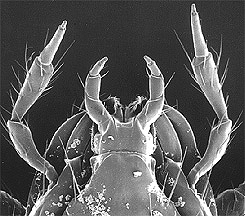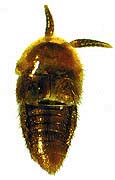Aleocharini
James S. Ashe (1947-2005) and Christian Maus


This tree diagram shows the relationships between several groups of organisms.
The root of the current tree connects the organisms featured in this tree to their containing group and the rest of the Tree of Life. The basal branching point in the tree represents the ancestor of the other groups in the tree. This ancestor diversified over time into several descendent subgroups, which are represented as internal nodes and terminal taxa to the right.

You can click on the root to travel down the Tree of Life all the way to the root of all Life, and you can click on the names of descendent subgroups to travel up the Tree of Life all the way to individual species.
For more information on ToL tree formatting, please see Interpreting the Tree or Classification. To learn more about phylogenetic trees, please visit our Phylogenetic Biology pages.
close boxIntroduction
The tribe Aleocharini includes a diverse assemblage of aleocharine staphylinids arranged into 3 subtribes, 16 genera, and over 460 species. The various members of the tribe display a diverse set of biological attributes. Members of the subtribe Aleocharina, particularly the genus Aleochara, are known to be ectoparasitic on fly puparia as larvae, though the biology of most other genera in the subtribe has not been investigated. Members of the subtribe Compactopediina are inquilines in the nests of termites (Kistner 1970b, 1982). Members of the single genus and species in the subtribe Hodoxenina are inquilines in the nest of the termite Microhodotermes viator (Hodotermitidae) (Kistner 1970a).
Members of the tribe Aleocharini are found in all zoogeographic regions and on all continents except Antarctica. Members of the subtribe Aleocharina are worldwide in distribution; the Compactopedina are found in the Oriental region; and the Hodoxenina are known only from South Africa.
Characteristics
The Aleocharini are characterized by the presence of 5-5-5 segmented tarsi and a pseudosegment on the last segment of the maxillary and labial palpi, so that the maxillary and labial palpi appear to be 5-articled and 4-articled respectively (Lohse 1974, Seevers 1978).


Figure. Aleochara sp., mouthparts, ventral aspect, showing pseudosegment on maxillary and labial palpi.
Seevers (1978) also noted that the velum of the parameres is reticulated, but this feature has not been examined for most taxa, and its generality among all members of the tribe is not known. The Aleocharini share this latter feature (as well as a pseudosegment on the last maxillary segment) with at least some members of the tribe Hoplandriini. Fenyes (1920-21) included several genera with 2- or 3-articled labial palpi in the tribe Aleocharini, but most of these genera have subsequently been moved to other tribes, though Piochardia (subtribe Aleocharini) with supposedly 3-articled labial palpi (Fenyes 1920-21) is still included in the tribe.
Discussion of Phylogenetic Relationships
The monophyly of the Aleocharini is not well established. Due to the shared characteristics discussed in the previous section, it is possible that this tribe may be paraphyletic in relation to the Hoplandriini.
The monophyly of the subtribe Aleocharina and the phylogenetic relationships among the 3 subtribes of the Aleocharini have not been investigated. However, it appears that the subtribe Aleocharina is based exclusively on plesiomorphic characteristics in comparison to the other subtribes.
References
Fenyes, A. 1920-21. Coleoptera, Staphylinidae, Aleocharinae. In: Wytsman, P.: Genera Insectorum, fasc. 173B-C. L. Desmet-Vertneuil, Bruxelles: 111-414
Kistner, D. H. 1970a. New termitophilous Staphylinidae from Hodotermitidae (Isoptera) nests. Jour. New York Entomol. Soc. 78: 2-16.
Kistner, D. H. 1970b. New termitophiles associated with Longipeditermes longipes (Haviland) II. The genera Compactopedia, Emersonilla, Hirsitilla, and Limulodilla. Jour. New York Entomol. Soc. 78: 17-32.
Kistner, D. H. 1982. A revision of the termitophilous genus Discoxenus with a study of the relationships of the genus and notes on its behavior (Coleoptera, Staphylinidae). Sociobiology 7(2): 165-186.
Lohse, G. A. 1974. Die Käfer Mitteleuropas. Staphylinidae II (Hypocyphtinae and Aleocharinae). Goecke & Evers, Krefeld, Germany. 381 pp.
Seevers, C. H. 1978. A generic and tribal revision of the North American Aleocharinae (Coleoptera: Staphylinidae). Fieldiana: Zoology 71: vi , 1-275.
Title Illustrations

| Scientific Name | Aleochara (Emplenota) pacifica |
|---|---|
| Location | Canada, B.C. |
| Size | length 5.6 mm |
| Copyright |
© 1997 James S. Ashe (1947-2005)

|
| Scientific Name | Aleochara (s.str.) lata |
|---|---|
| Location | Italy |
| Size | length 6.5 mm |
| Copyright |
© 1997 James S. Ashe (1947-2005)

|
| Scientific Name | Pseudocalea brevicornis |
|---|---|
| Location | Italy |
| Size | length 5.0 mm |
| Copyright |
© 1998 James S. Ashe (1947-2005)

|
| Scientific Name | Piochardia reitteri |
|---|---|
| Location | Albania |
| Size | length 3.5 mm |
| Copyright |
© 1997 James S. Ashe (1947-2005)

|
| Scientific Name | Discoxenus lepisma |
|---|---|
| Location | India |
| Size | length 2.2 mm |
| Copyright |
© 1997 James S. Ashe (1947-2005)

|
About This Page
Development of this page made possible by National Science Foundation PEET grant DEB 95-21755 to James S. Ashe and a DAAD grant D/97/05475 from the German Government to Christian Maus.
All images on this page copyright © 1997 James S. Ashe.
James S. Ashe (1947-2005)

University of Kansas, Lawrence, Kansas, USA

Bayer CropScience AG, Institute for Ecotoxicology, Monheim, Germany
Correspondence regarding this page should be directed to James S. Ashe (1947-2005) at
Page copyright © 1997 James S. Ashe (1947-2005) and
All Rights Reserved.
- First online 11 September 1998
Citing this page:
Ashe (1947-2005), James S. and Christian Maus. 1998. Aleocharini. Version 11 September 1998. http://tolweb.org/Aleocharini/9832/1998.09.11 in The Tree of Life Web Project, http://tolweb.org/
















 Go to quick links
Go to quick search
Go to navigation for this section of the ToL site
Go to detailed links for the ToL site
Go to quick links
Go to quick search
Go to navigation for this section of the ToL site
Go to detailed links for the ToL site